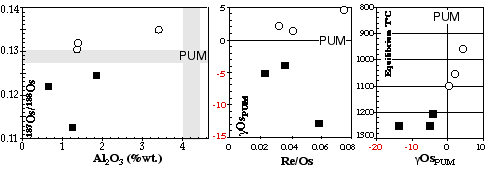Evidence for interaction of Proterozoic (2 Ga) sub-continental mantle with an enriched mantle plume from Re-Os isotope systematics in French Massif Central peridotite xenoliths
D.D. Lambert: Victorian Institute of Earth and Planetary Sciences, Department of Earth Sciences, Monash University, Melbourne, Victoria 3168, Australia; O. Alard: "Géofluides - Bassin - Eau" (U.M.R. 5569 CNRS.), ISTEEM, Université de Montpellier II, France. Present address : GEMOC, Macquarie; S. Costa, L.R. Frick: Victorian Institute of Earth and Planetary Sciences, Department of Earth Sciences, Monash University; J.L. Bodinier: "Géofluides - Bassin - Eau" (U.M.R. 5569 CNRS.), ISTEEM, Université de Montpellier II, France
Recent studies of mantle xenoliths and orogenic peridotite bodies have emphasised the consistent agreement between Re-Os melt-depletion (TRD) model ages for the mantle and ages of overlying and/or surrounding crust. Moreover, Re-Os isotopic investigations of sub-continental lithospheric mantle underlying non-cratonic areas suggest that these mantle segments have remained stable for long periods of time (> 1 Ga). However, several important questions remain to be answered. Does the lithospheric mantle remain coupled to the overlying continental crust through major and multiple orogenic events? Is there any age stratigraphy preserved within the continental mantle root?.
We have carried out petrographic, trace element and Re-Os isotopic studies of six shallow mantle peridotite xenoliths sampled by alkali basalts from localities scattered throughout the French Massif Central (FMC). The FMC is an appropriate lithospheric segment for assessing the behaviour of Re-Os isotopic systematics during major orogenic and magmatic events. The non-cratonic crust of the FMC has undergone at least two main orogenies (Cadomian and Variscan) during the past 700 Ma. More recently, the FMC lithosphere has been affected by a mantle plume which induced extensive Quaternary alkali volcanism. The six samples were subdivided into two groups. The first group consists of olivine-rich harzburgites displaying a poikiloblastic microtexture. They have high equilibrium temperatures, ranging from 1150°C to 1250°C, and very refractory geochemical characteristics with low Al2O3 and Lu contents (0.1 to 1.8 wt.% and 9 to 20 ppb, respectively). The geochemistry of constituent silicate minerals (e.g., olivine with low mg#) as well as whole rock trace element patterns suggest that these poikiloblastic olivine-rich peridotites have experienced "basaltic" melt infiltration at high melt/rock ratio. Their high equilibration temperatures may be consistent with a deep lithospheric mantle source. The second group of samples does not display a poikiloblastic microtexture, but have a porphyroclastic to protogranular microtexture. They are clinopyroxene-poor lherzolites (4 to 6% cpx) or lherzolites (11% cpx). Equilibrium temperatures within this group range from 950°C to 1100°C, Al2O3 contents vary from 1.3 to 3.5 wt.%, and Lu contents range from 10 to 57 ppb. Trace element diagrams show that the cpx-poor lherzolites are LREE enriched, whereas the lherzolites display "depleted MORB mantle" trace element patterns. However, samples from both groups display large positive U/Th anomalies in both whole rocks and separated clinopyroxenes.
These xenoliths display a large range in Os concentrations (1.74 to 3.60 ppb) that is inversely correlated with indices of mantle fertility, and exhibit a large range in Os isotopic compositions (187Os/188Os = 0.1122 to 0.1349; gOs = -13 to +4) that is inversely correlated with Re/Os (Fig. 1). Refractory harzburgite xenoliths have the lowest Os isotopic compositions (187Os/188Os= 0.1122 to 0.1138; gOs = -13 to -4), consistent with ancient melt-depletion and isolation from the convecting asthenospheric mantle for time periods of up to 2 Ga. Re-depletion (TRD) model ages obtained for the deepest refractory peridotites are entirely consistent with the lower Proterozoic age proposed for crust of Western Europe (e.g., Gebauer et al., 1989). These data further confirm that off-craton sub-continental mantle can remain stable even in lithospheric segments that exhibit severe and multiple orogenic events that have reworked the overlying continental crust.

Figure 1. Black squares are poikiloblastic and refractory xenoliths (group 1), white circles are non-poikiloblastic and more fertile peridotites (group 2). PUM is primitive upper mantle of Meisel et al. (1996). Equilibrium temperatures are obtained using the two-pyroxenes geothermometer of Brey and Khöler (1991).
However, the shallowest and most fertile xenolith samples from the FMC lithosphere have more radiogenic Os isotopic compositions (187Os/188Os= 0.1305 to 0.1349; gOs = +1 to +4) that are positively correlated with Re/Os and more radiogenic than "Primitive Upper Mantle" as defined by Meisel et al. (1996) (Fig. 1). These samples share only two characteristics: (1) they come from the uppermost part of the mantle lithosphere, relative to the poikiloblastic samples, and (2) they display positive U, Pb ± Sr anomalies. These anomalies are ascribed to percolation of a volatile-rich, small-volume melt through the upper lithospheric mantle (Alard et al., 1998). Therefore, these data together provide compelling evidence for the mobility of Os (but not Re) in metasomatic fluids derived from the mantle plume that has been tomographically imaged beneath the FMC (Granet et al., 1995). Thus, enriched mantle plume-derived metasomatic agents can mimic the Os isotopic effects observed in island-arc mantle that has been metasomatised by slab-derived fluids (Brandon et al., 1996). Alternatively, the petrological and geochemical differences between these two groups of samples might also be consistent with sampling a stratified lithospheric mantle, with more refractory lithologies occupying the deepest portions of this Proterozoic mantle root (Fig. 1).
Alard O., Bodinier J.-L., Lenoir X., Dautria J.-M., 1998, this volume.
Brandon A.D., Creaser R.A., Shirey S.B. and Carlson R.W. 1996, Science, 272, 861-864.
Brey G.P. and Köhler T. 1990, Journal of Petrology, 31, 1353-1378.
Gebauer, D., Williams, I.S., Compston W. and Grünenfelder M. 1989, Tectonophysics, 157, 81-96.
Granet M., Wilson M. and Achauer U. 1995, Earth Planet. Sci. Lett., 136, 281-296.
Meisel T., Biino G.G. and Nägler T.F. 1996, Geochim. Cosmochim.
Acta, 60, 2583-2593.

 GEMOC ARC National Key Centre
GEMOC ARC National Key Centre